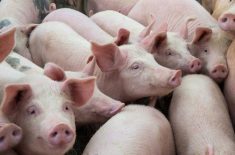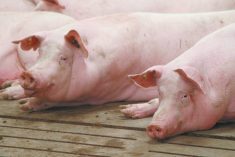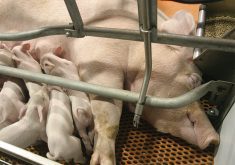People often do a double take when they see Malorie Aubé’s pigs.
The heritage breed sports a thick woolly coat of black hair (white on their bellies), with piglets having horizontal white striping along their sides. Mangalitsa pigs — which originated in Hungary in the 1830s — are also a “lard breed” with a lot of good, healthy fat on them.
“Mangalitsa pigs are a dual-purpose, heritage breed,” said Aubé, who farms with husband Tyler Parker and their three sons near the village of Bawlf.
“The animals don’t require a lot and have a good temperament.”

Lard was a staple, especially in Europe, in the 19th century, but as dietary preferences changed, the breed fell out of favour. By 1990, the species was on the verge of extinction, with fewer than 200 animals left. Hungarians took effort to preserve their heritage breed, and a few animals made their way to the U.S. a decade ago.
“There were a lot of animals in the States, but not a lot of breeders because most people only had one or two animals,” said Aubé.
An agrologist in her day job, she brought nine ‘swallow belly’ Mangalitsas (there are blond and red breeds) pigs to Canada in 2013 and has expanded her herd to 100 animals.
She’s also created a breeding program, crossing some of her stock with Duroc pigs, and will use genomics to learn more about the animals.
She’s also fallen in love with the friendly woolly critters.

“They are so calm and laid back,” she said.
The pigs are smaller than other heritage breeds, averaging from 300 to 400 pounds, and live outdoors with access to shelter. They have been thriving in the central Alberta climate, which Aubé says is similar to Hungary’s.
They like to root, forage and chew on branches, but they also get a complete ration and Aubé is working with provincial researchers at Lacombe Research Centre to determine the best feeding program for them.
Aubé and Parker, who follow permaculture principles, would like to finish their animals on the hazelnuts that they’ve planted on their property.
The pigs are slaughtered when they reach 300 pounds at 18 months, almost double the slaughter age of an average pig. Their carcass is about two-thirds fat and one-third meat (versus a 50/50 split in conventional pigs). The meat is redder, has more marbling, and a juicy tenderness that has earned it the nickname of the ‘Kobe Beef of Pork.’

Aubé is working with an Edmonton chef to create charcuterie products, including a cured back fat known as lardo, a dried bacon called coppa, an air-dried sausage, and a pancetta bacon. Pure fat from the pig can also be used as a cooking lard, or mixed with essential oil and used as a moisturizer. The fat in the products melts at body temperature.
“When it melts, you get a flavour explosion,” said Aubé.
Since most people have never tasted Mangalitsa, Aubé has to do a lot of education and work directly with customers.
“It’s an artisan, handmade, premium product,” she said.
















